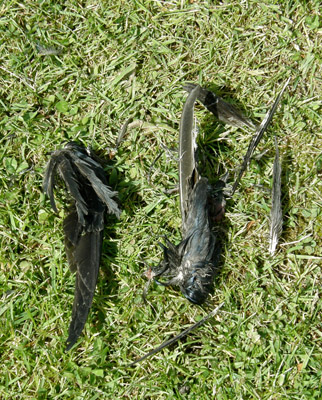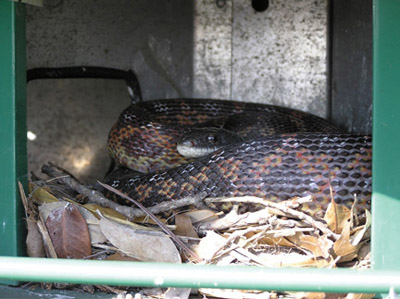Predation
Predators are everywhere. Whether a martin colony is located on a public park, at a school, or in your own backyard, Purple Martins are vulnerable to aerial predators such as hawks and owls, and ground predators such as raccoons, snakes, and squirrels. Here are some signs that predation has occurred at your colony site and ways to protect your Purple Martins.
Signs of Predation
Being aware of the signs of predation can help determine what kind of predator you have and the steps to take to prevent the problem from happening again.
Aerial-hawks and owls
Multiple feathers or wings below martin housing
Decoys turned upside down, or ripped off
Doors of housing ripped off or opened
Owl pellets (regurgitated pellets of non-digestible feathers and bones) below housing

Ground
Snakes: Missing eggs or nestlings; snakeskin in cavity or below martin housing; snake inside cavity
Raccoons: Blood on or in housing; wings or body parts scattered around martin housing

How to Protect Against Predation
The best time to protect your Purple Martins is before there is a problem. Having predator guards in place will help prevent predation—guards should be installed on ALL active housing.

Aerial
Housing—Make sure your Purple Martin colony is located in a clear area, away from any tall trees. Larger cavities will allow martins to build their nests further from the entrance, and out of a predators reach.
Guards and Cages—While hawks will hunt during the day, owls hunt at night. Owl/hawk guards in front of the cavities and wire cages surrounding the cavities will help prevent the predator from reaching and grabbing nestlings and adults. Many commercial owl and hawk guards are available,
Decoys—Decoys, while mainly used as an attraction tool, can also be used to distract hawks. Martin colonies can be noisy, especially around fledging time, and can be an attractant for hawks. The hawks will usually go after the slowest moving ‘martin’ and while they are attacking the decoy, that will give the real Purple Martins a chance to escape.
Ground
Housing—Make sure there are no wires leading from the ground or a building to the martin housing and keep the ground below the housing cleared of any tall vegetation in which predators could hide.
Pole Guards—Also called predator baffles, pole guards are cylindrical or conical in shape and help prevent raccoons or snakes from climbing up the pole. No matter if your pole is 12 or 20 ft tall, round or square, metal or wood, it can easily be climbed by snakes or raccoons. Pole guards are commercially available (we recommend a quick release pole guard for ease of use) or you can make your own. They should be installed at least 4 ft above the ground, 8 inches in diameter, and 2 ft long.
Netting—For those in areas with large snakes 1/2-3/4" bird netting can be used as a scondary line of defense. Netting should be placed above the predator baffle in puffy layers, ensuring there is no space for the snake to climb between the netting and pole, or over the netting. Wire can be used to create a form for the netting. To remove any captured snake, hold the snake by the head while wearing heavy gloves and use scissors to cut the netting away from the body. Snakes should be removed unharmed and released a few miles away from the colony. Netting does not prevent raccoons from climbing the pole and should always be used along with a baffle. Netting is a trap, rather than a guard and like all traps it needs to be closely monitored to ensure that any species caught by the trap are removed and released unharmed.
Recommended Reading:
Make Your Own Predator Baffle
Pole Guards
Coping with Avian Predators
Coping with Snakes
Predation Infographic
